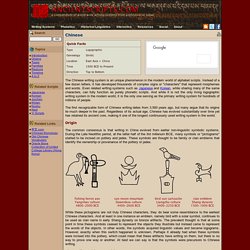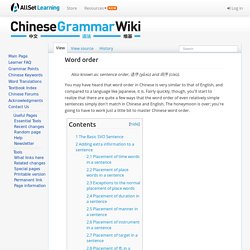

Diaspora. Orthography. Unacceptable definition. Chinese. The Chinese writing system is an unique phenomenon in the modern world of alphabet scripts.

Instead of a few dozen letters, it has developed thousands of complex signs or "characters" that represent morphemes and words. Even related writing systems such as Japanese and Korean, while sharing many of the same characters, can fully function as purely phonetic scripts. And while it is not the only living logographic writing system in the modern world, it is the only one serving as the primary writing system for hundreds of millions of people. The first recognizable form of Chinese writing dates from 3,500 years ago, but many argue that its origins lie much deeper in the past. Regardless of its actual age, Chinese has evolved substantially over time yet has retained its ancient core, making it one of the longest continuously used writing system in the world.
Origin The common consensus is that writing in China evolved from earlier non-linguistic symbolic systems. Word order - Chinese Grammar Wiki. Also known as: sentence order, 语序 (yǔxù) and 词序 (cíxù).

You may have heard that word order in Chinese is very similar to that of English, and compared to a language like Japanese, it is. Fairly quickly, though, you'll start to realize that there are quite a few ways that the word order of even relatively simple sentences simply don't match in Chinese and English. The honeymoon is over; you're going to have to work just a little bit to master Chinese word order. The Basic SVO Sentence On this level, Chinese word order very closely matches English word order. This concept shouldn't take long at all to master. Adding extra information to a sentence More details can be added to the basic sentence structure. Placement of time words in a sentence. A Gentle Introduction to Chinese Sentence Structure. Is Mandarin Chinese as difficult as everyone says?

For beginners whose native language is English, I would say that it is as difficult as everyone says – it’s hard as hell. The challenge lies in the fact that there are so many new things to master: for example, pinyin, pronunciation, a new writing system and a totally different approach to grammar. The way to overcome this complexity is to break it down and to see each piece in isolation. When you do that, it actually becomes much simpler, and even logical. Social Etiquette / Modales Sociales - Learn Spanish with Polly Lingual.
ELI5: Was Grammar invented or is it an innate thing humans know? What Are Past Participles. If it's a regular verb, the past participle is the same as the simple past tense.

In other words, it is formed like this: Add "ed" to most verbs: jump > jumpedpaint > painted If a verb of one syllable ends [consonant-vowel-consonant], double the final consonant and add "ed": chat > chattedstop > stopped If the final consonant is w, x or y, don't double it: sew > sewedplay > playedfix > fixed If last syllable of a longer verb is stressed and ends [consonant-vowel-consonant], double the last consonant and add "ed": incur > incurred prefer > preferred If the first syllable of a longer verb is stressed and the verb ends [consonant-vowel-consonant], just add "ed": open > opened enter > entered swallow > swallowed If the verb ends "e", just add "d": thrive > thrived guzzle > guzzled If the verb ends [consonant + "y"], change the "y" to an "i" and add "ed": cry > cried fry > fried If it's an irregular verb, the past participle is formed in all sorts of different ways.
The Present Perfect Simple Tense. The Perfect Tenses The opinion of many native and non-native English speakers is that the perfect tenses are far from being ‘perfect’.

They cause headaches for most people. On these pages, we will break the perfect tenses down into short sections that will make them easier to understand. Useful Tip Time Expressions in the Present Perfect Use since with a specific year or a period in the past > since 2002 / since I was a childUse for with a number of years > for twenty yearsUse ever and yet in questions and negatives > Have you ever / hasn’t been yetUse already and never, just between have/has and the verb > has already finished / have just beenUse before, since, for, already, many times, so far, yet at the end of a sentence or questions > Have you been there before? The Essential Guide to Speaking Spanish Like a True Mexican.
Looking to have a huge head start when you travel to Mexico?

Want to impress the locals with your Spanish? Whether you want to better understand what’s going on around you or show off your language skills, one thing is true: Direct Commands in Spanish — The Imperative Mood. By Gerald Erichsen Updated April 24, 2016.

The imperative form of verbs, used for giving commands, is one of the more unusual verb forms in Spanish. As a distinctive conjugation, it exists only with tú and vosotros, that is, in the familiar second person. Different conjugations are sometimes used in the affirmative (do something) and negative (don't). And because direct commands sometimes can sound rude or impolite, the imperative form is avoided sometimes in favor of other verb constructions.
The imperative form of verbs is fairly easy to learn. Gender of Nouns: Part Two. Home / Grammar / Topic.

Gender of Nouns. Home / Grammar / Gender of Nouns Part I Notes: The written lesson is below.Links to quizzes, tests, etc. are to the left.

A noun is a word used to denote a person, place, thing, or idea. Person: John, girl, dentistPlace: garden, university, VenezuelaThing: book, car, tomatoIdea: liberty, despair, intelligence In Spanish, all nouns are either masculine or feminine. The idea that nouns have gender seems perfectly natural when the noun stands for a living creature. The following Spanish nouns all denote living creatures. el gato male cat. Learn Spanish. The Essential Scots Dictionary: Scots-English, English-Scots - Iseabail Macleod, Pauline Cairns. To exaggerate and overstate - synonyms and related words.
How language can affect the way we think. Keith Chen (TED Talk: Could your language affect your ability to save money?)

Might be an economist, but he wants to talk about language. For instance, he points out, in Chinese, saying “this is my uncle” is not as straightforward as you might think. In Chinese, you have no choice but to encode more information about said uncle. How ampersand came from a misunderstanding. Johnson & Johnson, Barnes & Noble, Dolce & Gabbana: the ampersand today is used primarily in business names, but that small character was once the 27th part of the alphabet.
Where did it come from though? The origin of its name is almost as bizarre as the name itself. Word Fact: What Is the Difference Between “Discreet” and “Discrete”? This is another pair of homophones (words that sound alike but are different in meaning, spelling, or both) that can be very confusing. Discreet implies the showing of reserve and prudence in one’s behavior or speech.
Discrete means something quite different: “distinct, separate, unrelated.” Both words derive from the same Latin word discretus meaning “separated.”